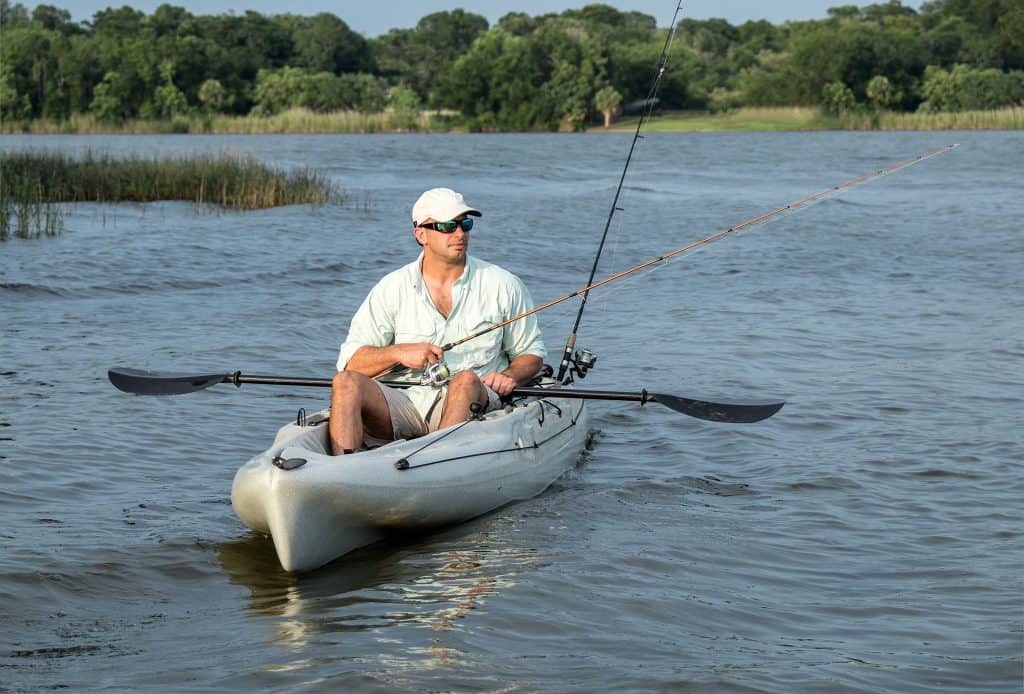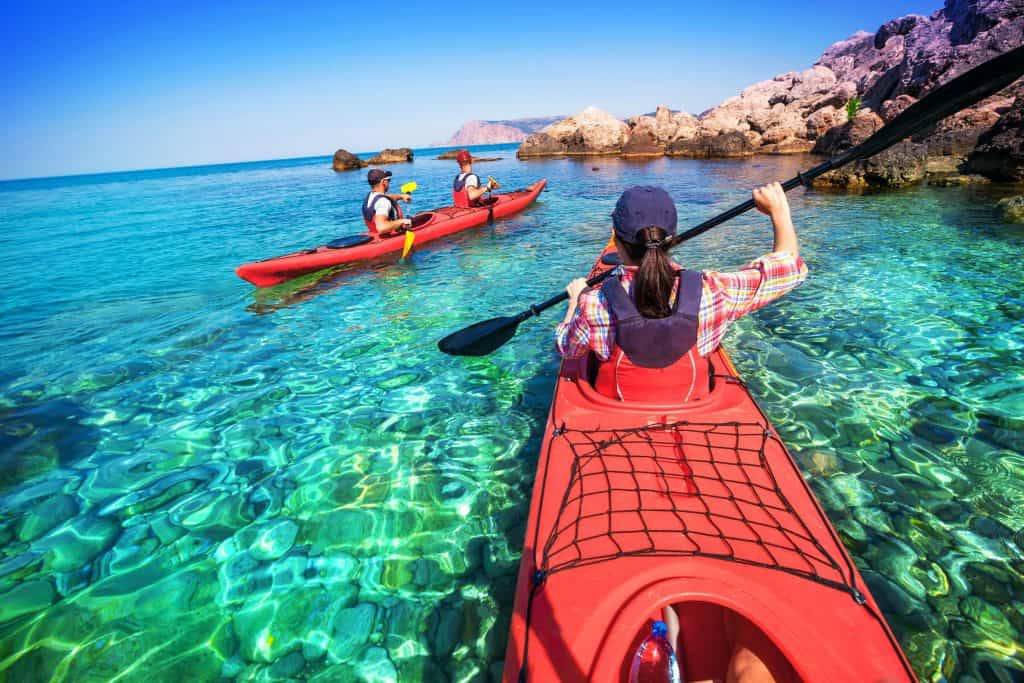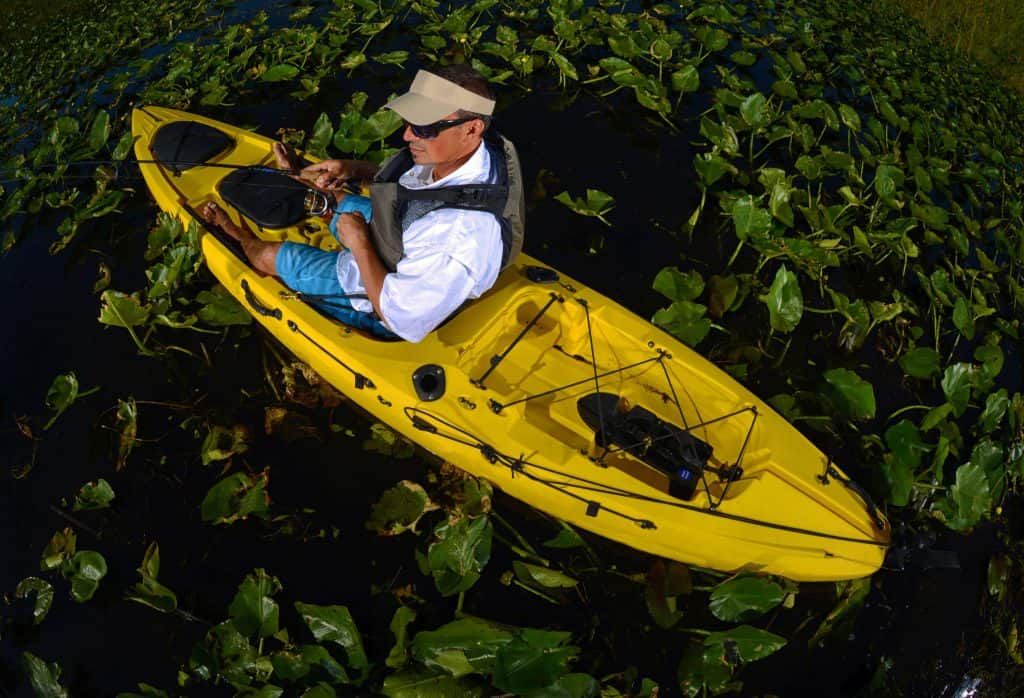
While out fishing one day, I saw someone kayak by. I then began wondering, if I could possibly fish from inside a kayak. I did the research to see find out if fishing in a kayak was safe or not, and here is what I found.
Is fishing in a kayak safe? While any activity on a body of water has its noted dangers, fishing from a kayak is a common practice. There is however, a need to understand how to fish from inside the kayak safely. Before learning to fish from a kayak make sure you can use a kayak safely on its own.
The first time I went kayaking, I had a great time out on the lake. Everything went well until I attempted to exit my kayak near a pier.
Below I will talk about some kayakers tips for beginner use, and then will address fishermen’s tips for how to successfully (and safely) fish from inside a kayak.
Safety First!
All kayakers, boaters, or fishermen alike should understand that safety on or near the water should come first. To better understand how safety can be achieved while fishing, kayaking, or doing anything on or around a body of water read the tips given below.
When participating in any activity on the water, everyone should always be wearing a life jacket or other personal flotation device. Ensure that each person’s life jacket is not only designed to specifically fit their age, size, and swimming capabilities but that they are also wearing their life jackets properly.
A common mistake regarding the use of life jackets that can lead to dangerous circumstances is assuming that any life jacket will work for any person. Small children should wear life jackets designed to keep them from slipping out the bottom; whereas, adults should be wearing life jackets that aren’t too short or too long on them.
Straps should be tightened to the point that if someone were to push up on the jacket, you would not slip out. Make sure that the life jacket also doesn’t inhibit the movement of the user. While the flotation device should be tight, it should also be comfortable for the user.
After ensuring that everyone is wearing a life jacket, it is important for everyone to understand the potential dangers of the rivers. Currents, undertows, and submerged debris all offer a new risk when participating in any activity out on the water.
However, with a basic understanding of each of these dangers, the risk can be greatly minimized.
When kayaking, you should understand how the river affects your kayak. You should also be well versed on the “signs” of the water. Knowing how the water may act can help you prepare for
It is commonly known that the rush of water and rivers can make for a difficult time trying to hear or even see the person you need to communicate with. To many people’s surprise, there is a hand signal system designed specifically for kayakers while out on the water. You and anyone who goes kayaking with you should learn and understand some of these basic hand signals.
Make sure you have a plan of where, when, and with whom you are going. Share this plan with someone not in the group and have a plan for what to do if the group does not arrive at the take-out location before a certain time.
One of the most important things you can do to remain safe while out on the water is to not plan a trip that is beyond your abilities. If you have never been kayaking before, a calm lake trip may be a better choice than attempting to tackle the white water rapids. Ensure whatever trip you plan, all members of the group feel confident in their abilities to handle the situation.
The final tip to maximize your safety on the water is to make smart decisions. Having the knowledge of water and boating safety and the gear to keep you safe will only be effective if you and all the members of your group are making safe and sensible decisions.
While having fun and enjoying your time while kayaking is of great importance, safety should always come first.
Creatures to Watch Out For
While the area in which you are fishing will determine what animals you may see while out kayaking, it is important to know what to watch out for and how to react.
A common creature to watch out for while kayaking is snakes. Snakes can be seen in both fresh and salt water. If you notice one approaching you, try to deter it by smacking the water with your paddle (Do not hit the snake! Remember you are a visitor in their home!).
In some freshwater areas, you may need to watch out for approaching beavers. While they might often seem cute and cuddly, they can become aggressive. Once again, a few paddle slaps may deter the beaver from coming closer.
The next creature on our watch list is alligators. For the most part, alligators will not mind you passing by but if you see one, be sure you don’t overstay your visit. It is best to not anger alligators by sticking around too long or wading near their homes.
For salt or even brackish waters, you may have the chance to encounter sharks while kayaking. Most sharks will gently bump the kayak to see if it is a possible source of food. When they discover it is, in fact, plastic, they will move on. It is a rare occasion that a shark bites a kayak. In the event that it does, the best strategy is to remain calm.
Beginner Kayaking Tips

Before even setting out on a kayaking adventure, you should learn how to properly manage the kayak. This may take a great deal of practice but it is well worth the effort.
The first tip before setting out is to dress more for the water than for the weather. This is due to the fact that while kayaking you subject yourself to the risk of submersion.
Dressing in layers may weigh you down in the event of flipping your kayak and therefore is not the best choice of clothing. If you would wear a normal swimsuit in those waters, wear one kayaking.
Second, make sure you are aware of what to do in the event your kayak flips. At a local pool, you can often see kayakers that are purposefully flipping their kayaks to practice flipping them back over. Doing this helps to ensure that in the event of an emergency you will be able to act quickly and make the correct decision.
Next, it is suggested that you learn how and when to use the different methods of paddling. While this may seem cliche, you should practice your paddling stroke before even getting in the water. This practice can be done sitting in an armless chair, with either a real paddle or a stick that is similar in size.
Many kayakers suggest packing duct tape along for your trip. In the event that your paddle cracks, duct tape may give you the quick fix needed to keep going. As well as this, duct tape can be utilized to secure any of your gear or items from sliding around the kayak.
Make sure that you understand each of the
First, ensure your feet and legs are properly inside the kayak. There should either be a foothold or peg for you to place your feet in. Make sure your toes are pointing out and that your thighs reach the braces.
Next, focus on the paddling technique you practiced before. Now that you are actually on the water, get a feel for how the different paddling styles affect your movement. Remember, kayaking does not have to be a race, so take a deep breath and go slow at first.
Like any water activity, you should remain alert to your surroundings. Be alert for animals, rocks, or submerged trees that may end up in your way. The last thing you want to be is distracted and accidentally flip your kayak.
It’s also important that you do not fight against your kayak. Kayaking requires great balance, so as the kayak moves, move with it. Fighting against the kayak’s movements can result in flipping it.
The final beginner kayaking tip is to make sure you are stretching before and after your trip (as this will minimize the chances of cramps or injuries
Kayaking can be a wonderfully relaxing activity. While plenty of practice is needed to truly master kayaking, the only real way to become better is to push off and enjoy the rid. After all, you can’t master a kayak from the shore!
Check out our other article, “Can a Kayak Sink?”
Tips for Fishing in a Kayak
Kayaking can be difficult on its own, and adding fishing on top of that can add a greater level of difficulty into the mix.
The first tip may be one of the most important for your kayak fishing trip. Fish smarter, not harder. Since you are fishing in a whole new way, be sure to focus more on the strategic ways you can be successful, rather than just hoping to muscle your way to success.
As mentioned in the section above, paddling and balance are some of the most important skills needed for kayaking. These skills become even more important when casting a line.
Before attempting to start fishing from your kayak, start by practicing paddling with one hand (since the other will be occupied by the fishing rod). This may be quite difficult, so take your time to learn the best way to do this.
Always keep your paddle at the ready, since you may need to quickly manuever the kayak to land that big catch.
Learn and practice your “drifting” skills. Speed definitely will not assist you in catching a fish. Take your time and learn how to keep the kayak on track without moving too fast. The best way to do this is by single, gentle strokes on one side of the kayak. If the kayak begins to veer off course, give a light stroke from the opposite side.
If you are just planning on fishing from one area, pins or anchors can be used to either hold you in place or help face the direction you are planning on going (this is especially useful for moving against the current or wind).
Finally, make sure you have the proper gear to catch the fish you are looking for. Since the kayak provides a little more drag, you should consider using a heavier or larger strength of fishing line.
For more pros and cons of fishing from a kayak click here!
Buying the Best Kayak for Fishing

In order to really be successful while kayak fishing, not only do you need to know the basics of kayaking, you should also know which kayak is going to suit you best.
To better understand which kayak you should be looking to buy, remember that no two kayaks are the same and neither are the kayakers. With that in mind, we can then say that there will be no perfect kayak that works best for everyone.
The best way to decide which kayak truly is the best fit for you is to visit any stores around you that sell kayaks and ask them if you can demo a few models. Many stores will allow you and may even encourage you to test the kayak out before purchase. They can also provide recommendations suited to your skillset and experience.
There are two different types of kayaks you can consider purchasing. Either a “sit on kayak” or a “sit-in kayak.” Sit on kayaks may offer more stability and room for movement. However, sit-in kayaks are more suitable when it comes to faster moving waters.
One of the newest designs of kayaks features a new way of movement. While the most common versions of kayaks utilize paddle power, the newer designs feature pedals instead. If you would prefer to use pedals rather than a paddle while fishing, look into one of the newer designs.
The next few items of consideration when buying a kayak are length, width, and weight. Longer kayaks offer more speed with less maneuverability. A wider kayak may offer a great carrying capacity with more stability.
As for the weight of your kayak, consider what is the maximum load your vehicle can carry, and whether or not you will be able to carry the kayak to the water. If not, there may be need of a kayak cart to assist in moving the kayak from the car to the water.
The final details you should consider are storage, seat design, and ability to stand in the kayak. If you plan on carrying more things look for a kayak with more storage capacity.
Many kayaks come with attached hard plastic seats; however, newer versions offer seats that may be more comfortable and offer better support.
As for the ability to stand in your kayak, this generally only applies if you plan on doing any sight fishing. If not the ability to stand in the kayak while on the river may not be as important of a factor.
When purchasing your fishing gear, you should decide, how and for what you would be fishing. This process helped you to better understand which gear would best suit your needs.
Be sure to check out the 9 best fishing kayaks available online!
Top 6 Kayak Brands
While even a generic brand can produce a product that will get the job done, it is still nice to know which brands have been deemed “the best.”
While seraching for the perfect kayak, I found the following to be the top brands.
I encourage you to take a look at these brands and to also check out any other brands offered at your local hardware or outdoor stores. After all, just because these brands worked well for someone else, does not mean they will necessarily be the best for your fishing/kayaking needs.
Related Questions
Is it safe to kayak in the ocean? While kayaking can be done in the ocean, there is still a great need for safety. When kayaking always make sure to wear a life jacket! For more experienced kayakers a “sit-inside” kayak can be suitable for the ocean.
However, in the event that the kayak fills with water, you would need to be able to swim the kayak back to shore and this could prove difficult for a beginner.
Can you anchor a kayak? Like other boats, a kayak can be anchored. You will need the anchor itself, enough line to match the depth of the water you are in and a floater at the top of the line. The floater is used in case the kayak and anchor somehow separate from each other.
What is the difference between a kayak and a canoe? While kayaks and canoes are both smaller boats that can be suitable for either recreational or fishing purposes, canoes are designed so that the paddler may either kneel on the boat floor or sit on a raised “bench” seat. Meanwhile, kayaks are designed so that the paddler sits in a seat usually placed directly on the boat floor. The designs of their paddles are also different. For our full article click here.
